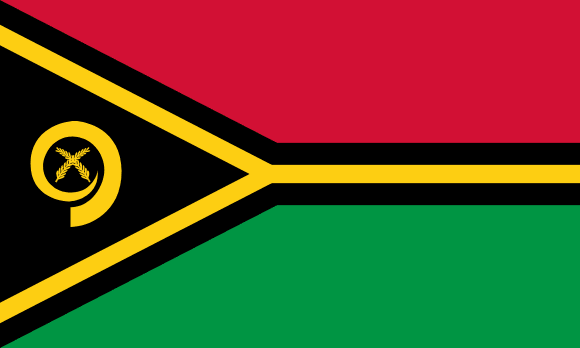Vanuatu Flag

Vanuatu's flag, popularly known as the “Flag of Independence,” was adopted on February 18, 1980, and is made up of red, green, black, and yellow colors. The flag was created to represent Vanuatu's rich culture, history, and people's unity.
A parliamentary committee chose the flag design, which is based on a flag created by local artist Kalontas Malon in 1977 and adopted by the Vanua'aku Pati, a political party that fought for Vanuatu's independence from France and the United Kingdom. Vanuatu gained independence on July 30, 1980, and the flag was formally adopted on that day.
The red tint on the flag symbolizes the blood of the ni-Vanuatu people who fought for the country's independence. The color green signifies the richness of the land and the people's sustainable livelihoods. The dark hue signifies Vanuatu's Melanesian people, while the yellow color represents the country's sand beaches, sunshine, and friendly people.
Vanuatu flag downloads
- completely free for commercial and non-commercial use (public domain)
- based on vector file from Wikipedia Commons
- PNG or WebP format (lossless compression)
- Right click on the links (save link as)
| Width | Height | PNG | WebP |
|---|---|---|---|
| 20px | 12px | ~0.1 KB | ~0.1 KB |
| 40px | 24px | ~0.4 KB | ~0.1 KB |
| 80px | 48px | ~0.7 KB | ~0.1 KB |
| 160px | 96px | ~2.6 KB | ~0.6 KB |
| Width | Height | PNG | WebP |
|---|---|---|---|
| 16px | 12px | ~0.1 KB | ~0.1 KB |
| 40px | 30px | ~0.4 KB | ~0.1 KB |
| 80px | 60px | ~0.8 KB | ~0.1 KB |
| 128px | 96px | ~2.5 KB | ~0.6 KB |
- completely free for commercial and non-commercial use (public domain)
- based on vector file from Wikipedia Commons
- PNG, WebP (lossless compression) or JPEG format (100% quality)
- Right click on the links (save link as)
| Width | Height | PNG | WebP | JPEG |
|---|---|---|---|---|
| 2560px | 1536px | ~2.6 KB | ~0.6 KB | ~34.9 KB |
| 1280px | 768px | ~0.7 KB | ~0.1 KB | ~13.0 KB |
| 640px | 384px | ~0.4 KB | ~0.1 KB | ~5.6 KB |
| 320px | 192px | ~0.2 KB | ~0.1 KB | ~2.8 KB |
| 160px | 96px | ~0.1 KB | ~0.1 KB | ~1.5 KB |
| 80px | 48px | ~0.1 KB | ~0.1 KB | ~0.9 KB |
| 40px | 24px | ~0.1 KB | ~0.1 KB | ~0.6 KB |
| 20px | 12px | ~0.1 KB | ~0.1 KB | ~0.4 KB |
- completely free for commercial and non-commercial use (public domain)
- based on vector file from Wikipedia Commons
- SVG, PDF (Adobe Acrobat), AI (Adobe Ilustrator) or EPS format
- Right click on the links (save link as)
| Format | SVG | AI | EPS | |
|---|---|---|---|---|
| Vector download | ~0.3 KB | ~12.5 KB | ~29.7 KB | ~1533.8 KB |
Country information
Vanuatu is a country located in the South Pacific Ocean, east of Australia and New Zealand. It is a small, culturally diverse country with a mix of different ethnicities and religions. Vanuatu is known for its stunning natural beauty, with a varied landscape ranging from mountains and forests to beaches and coral reefs.
The history of Vanuatu dates back to ancient times, with the first human settlements dating back to at least 1000 BC. The country has a long and complex history, with a mix of Melanesian, Polynesian, and other influences. Vanuatu gained independence from France and the United Kingdom in 1980, and has since gone through a number of political and economic challenges.
Today, Vanuatu is a lower-middle-income country with a small and diversified economy. The country is known for its agricultural industry, as well as for its production of livestock, coconut oil, and other products. Vanuatu has a tropical climate, with hot and humid weather year-round. The official languages of Vanuatu are English, French, and Bislama.
| Independent | Yes |
| Country codes | VU, VUT (ISO 3166-1) |
| Official name | Republic of Vanuatu |
| Official languages | Bislama, English, French |
| Religion | 93.3% Christianity, 4.1% Folk religions, 1.2% None, 1.4% Others |
| Capital city | Port Vila |
| Continent | Oceania |
| Time zone | UTC+11 (VUT (Vanuatu Time)) |
| Member of | United Nations |
| Commonwealth of Nations | |
| Pacific Community | |
| Population | 325,757 (2023) |
| Population density | 25 per Km2 (65 people per mi2) |
| Urban Population | 24.4 % of the population is urban (75,025 people in 2020) |
| Migrants (net) | 120 |
| Median age | 21.1 years |
| Total area | The total land area is 12,190 Km2 (4,707 sq. miles) |
| Highest point | Mount Tabwemasana on Espiritu Santo (1 877 m, 6 158 ft) |
| Lowest point | South Pacific Ocean |
| GDP per capita | $ 2,996 (World Bank, 2021) |
| Currency | Vanuatu vatu (Vt, VUV) |
| Calling code | +678 |
| Internet TLD | .vu (click here to find and register domain name) |
| Country Wikipedia Page | Vanuatu Wikipedia Page |
Main Cities by Population in Vanuatu
| # | CITY NAME | POPULATION |
|---|---|---|
| 1 | Port-Vila | 35,901 |
